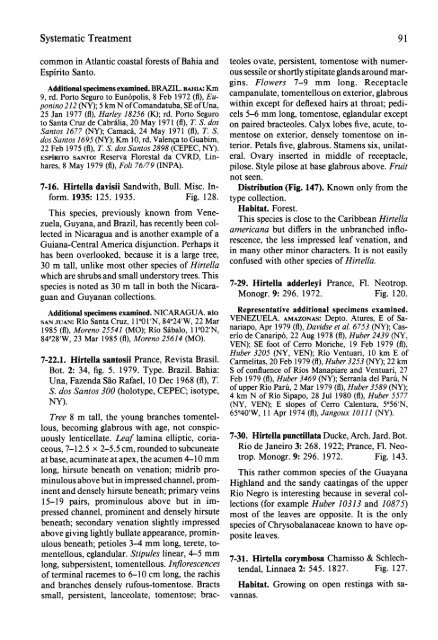flora neotropica - CNCFlora
flora neotropica - CNCFlora
flora neotropica - CNCFlora
You also want an ePaper? Increase the reach of your titles
YUMPU automatically turns print PDFs into web optimized ePapers that Google loves.
Systematic Treatment 91<br />
common in Atlantic coastal forests of Bahia and<br />
Espirito Santo.<br />
teoles ovate, persistent, tomentose with numerous<br />
sessile or shortly stipitate glands around margins.<br />
Flowers 7-9 mm long. Receptacle<br />
Additional specimens examined. BRAZIL. BAHIA: Km<br />
9, rd. Porto Seguro to Eunopolis, 8 Feb 1972 (fl), Eu- campanulate, tomentellous on exterior, glabrous<br />
ponino 212 (NY); 5 km N ofComandatuba, SE of Una, within except for deflexed hairs at throat; pedi-<br />
25 Jan 1977 (fl), Harley 18256 (K); rd. Porto Seguro cels 5-6 mm long, tomentose, eglandular except<br />
to Santa Cruz de Cabralia, 20 May 1971 (fl), T. S. dos on paired bracteoles. Calyx lobes five, acute, to-<br />
Santos 1677 (NY); Camaca, 24 May 1971 (fl), T. S.<br />
dos Santos 1695 (NY); Km 10, rd. Valenqa to<br />
mentose on<br />
Guabim,<br />
exterior, densely tomentose on in-<br />
22 Feb 1975 (fl), T. S. dos Santos 2898 (CEPEC, NY).<br />
terior. Petals five, glabrous. Stamens six, unilat-<br />
ESPiRITO SANTO: Reserva Florestal da CVRD, Lin- eral. Ovary inserted in middle of receptacle,<br />
hares, 8 May 1979 (fl), Foli 76/79 (INPA). pilose. Style pilose at base glabrous above. Fruit<br />
not seen.<br />
7-16. Hirtella davisii Sandwith, Bull. Misc. In- Distribution (Fig. 147). Known only from the<br />
form. 1935: 125. 1935. Fig. 128. type collection.<br />
This species, previously known from Vene-<br />
Habitat. Forest.<br />
zuela, Guyana, and Brazil, has recently been col-<br />
This species is close to the Caribbean Hirtella<br />
lected in Nicaragua and is another example of a<br />
americana but differs in the unbranched inflo-<br />
Guiana-Central America disjunction. Perhaps it rescence, the less impressed leaf venation, and<br />
has been overlooked, because it is a<br />
in<br />
large tree,<br />
many other minor characters. It is not easily<br />
30 m tall, unlike most other species of Hirtella<br />
confused with other species of Hirtella.<br />
which are shrubs and small understory trees. This<br />
species is noted as 30 m tall in both the Nicara- 7-29. Hirtella adderleyi Prance, Fl. Neotrop.<br />
guan and Guyanan collections.<br />
Monogr. 9: 296. 1972. Fig. 120.<br />
Additional specimens examined. NICARAGUA. RIO Representative additional specimens examined.<br />
SAN JUAN: Rio Santa Cruz, 1101 'N, 84?24'W, 22 Mar VENEZUELA. AMAZONAS: Depto. Atures, E of Sa-<br />
1985 (fl), Moreno 25541 (MO); Rio Sabalo, 11?02'N, nariapo, Apr 1979 (fl), Davidse et al. 6753 (NY); Cas-<br />
84?28'W, 23 Mar 1985 (fl), Moreno 25614 erio de<br />
(MO).<br />
Canaripo, 22 Aug 1978 (fl), Huber 2439 (NY,<br />
VEN); SE foot of Cerro Moriche, 19 Feb 1979 (fl),<br />
Huber 3205 (NY, VEN); Rio Ventuari, 10 km E of<br />
7-22.1. Hirtella santosii Prance, Revista Brasil. Carmelitas, 20 Feb 1979 (fl), Huber 3253 (NY); 22 km<br />
Bot. 2: 34, fig. 5. 1979. Type. Brazil. Bahia: S of confluence of Rios Manapiare and Ventuari, 27<br />
Una, Fazenda Sao Rafael, 10 Dec 1968 (fl), T. Feb 1979 (fl), Huber 3469 (NY); Serrania del Parfi, N<br />
S. dos Santos 300<br />
of<br />
(holotype, CEPEC; isotype,<br />
upper Rio Pari, 2 Mar 1979 (fl), Huber 3589 (NY);<br />
4 km N of Rio Sipapo, 28 Jul 1980 (fl), Huber 5577<br />
NY).<br />
(NY, VEN); E slopes of Cerro Calentura, 5?56'N,<br />
Tree 8 m tall, the young branches tomentel- 65?40'W, 11 Apr 1974 (fl), Jangoux 10111 (NY).<br />
lous, becoming glabrous with age, not conspicuously<br />
lenticellate. Leaf lamina elliptic, coria- 7-30. Hirtella punctillata Ducke, Arch. Jard. Bot.<br />
ceous, 7-12.5 x 2-5.5 cm, rounded to subcuneate Rio de Janeiro 3: 268. 1922; Prance, Fl. Neoat<br />
base, acuminate at apex, the acumen 4-10 mm trop. Monogr. 9: 296. 1972. Fig. 143.<br />
long, hirsute beneath on venation; midrib pro- This rather common species of the Guayana<br />
minulous above but in impressed channel, prom- Highland and the sandy caatingas of the upper<br />
inent and densely hirsute beneath; primary veins Rio Negro is interesting because in several col-<br />
15-19 pairs, prominulous above but in im- lections (for example Huber 10313 and 10875)<br />
pressed channel, prominent and densely hirsute most of the leaves are opposite. It is the only<br />
beneath; secondary venation slightly impressed species of Chrysobalanaceae known to have opabove<br />
giving lightly bullate appearance, promin- posite leaves.<br />
ulous beneath; petioles 3-4 mm long, terete, tomentellous,<br />
eglandular. Stipules linear, 4-5 mm<br />
7-31. Hirtella<br />
long, subpersistent, tomentellous.<br />
corymbosa Chamisso & Schlech-<br />
Inflorescences<br />
of terminal racemes to 6-10 cm long, the rachis<br />
tendal, Linnaea 2: 545. 1827. Fig. 127.<br />
and branches densely rufous-tomentose. Bracts Habitat. Growing on open restinga with sasmall,<br />
persistent, lanceolate, tomentose; brac- vannas.

















